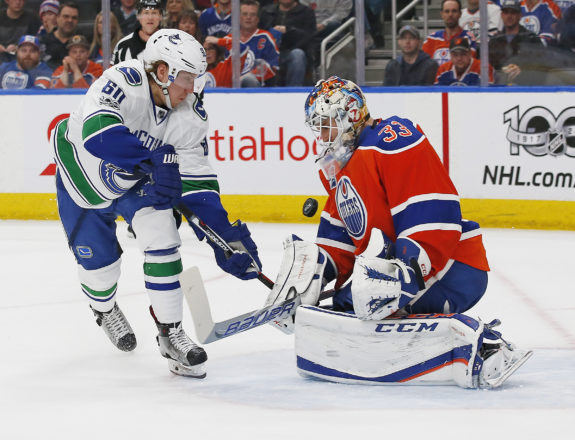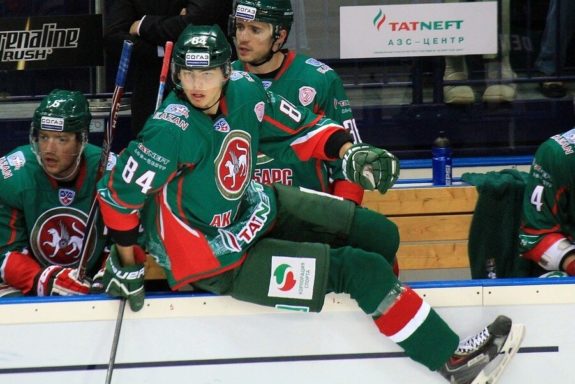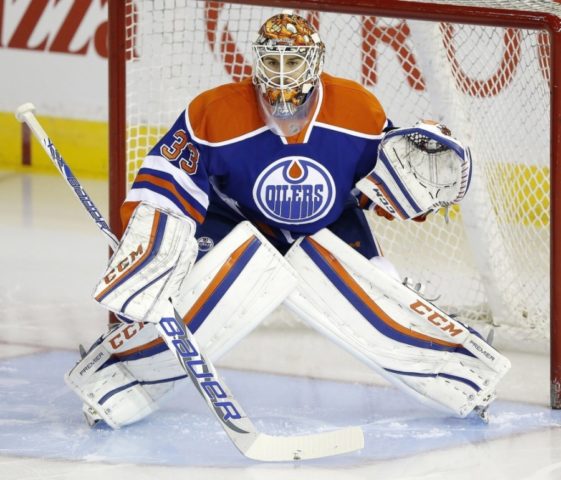It’s not often that you see goaltenders rise from the backup role to take on the starter role with almost immediate success. But nearly two years ago, that’s exactly what Cam Talbot did with the Edmonton Oilers following a trade that sent the goaltender to Edmonton from the New York Rangers.
Talbot went from playing in the shadow of Henrik Lundqvist on Broadway to taking the reins in Edmonton and it didn’t cost the Oilers too much to find themselves a capable starting goaltender in the 28-year-old Talbot.
Now, 30, Talbot is headed into his third season with the Oilers and coming off his best statistical season of his short NHL career. Add to that the playoff experience he’s gained in Edmonton and the Oilers filled a major hole in their lineup when they acquired Talbot on June 27, 2015. But how exactly did they pry this talented net minder from the grasps of the Rangers?
Simply put, it didn’t take much.
Getting Talbot: Oiling Up the Offer
Talbot first entered the NHL as a backup to Lundqvist in 2013-14. As a 26-year-old, he played 21 games for the Rangers in his rookie season finishing with an impressive 12-6-1 record and posting a .941 save percentage to go along with a 1.64 goals against average.

What made it better was that it wasn’t just a fluke. Talbot backed up those numbers with another decent year in 2014-15 – again backing up King Henrik – while playing 36 games in his second season with the club.
He finished his Ranger career with a 33-15-5 record in 57 regular season games along with a .931 save percentage and 2.00 goals against average. Still, Talbot’s role in New York was clear. He was a backup goaltender and if he was going to start at the NHL level it wouldn’t be with the Rangers.
So, on June 27, 2015, the Edmonton Oilers packaged three picks in the 2015 NHL Entry Draft and acquired what would be their starting goalie for the next couple of years along with a pick of their own.
| Going to Edmonton | Going to New York |
| G Cam Talbot | 2015 2nd-round pick (#57 – Jonas Siegenthaler) *Traded to Washington* |
| 2015 7th-round pick (#209 – Ziyat Paigin) |
2015 3rd-round pick (#79 – Sergey Zborovskiy) |
| 2015 7th-round pick (#184 – Adam Huska) |
At the time, the Oilers were acquiring a 28-year-old goalie with just 57 games of NHL experience. Sure, his numbers were starter-worthy in his short time at the top level, but he had never played more than 36 games in a season and he had just two seasons under his belt.
Still, the Oilers felt they were acquiring a top-talent goaltender to carry their developing franchise in net.
Along with Talbot, the Oilers acquired a 2015 seventh-round pick. They used it to take Ziyat Paigin from Ak Bars Kazan of the KHL.

In return, the Oilers sent a second-round pick, a third-round pick and a seventh-round pick in 2015 to the Rangers. The Rangers traded away the second-round pick before using the third rounder to take Sergey Zborovskiy out of the WHL and the seventh rounder to take Adam Huska of the USHL’s Green Bay Gamblers.
Fallout From the Talbot Trade
As mentioned, the Rangers traded the second-round pick they received from the Oilers to the Washington Capitals. The Capitals used the pick to draft Jonas Siegenthaler of the ZSC Lions. In return, the Rangers received a third-round pick (taking Robin Kovacs) and a fourth-round pick (taking Brad Morrison) in the 2015 draft.
| Going to Washington | Going to New York |
| 2015 2nd-round pick (#57 – Jonas Siegenthaler) |
2015 3rd-round pick (#62 – Robin Kovacs) |
| 2015 4th-round pick (#113 – Brad Morrison) |
With that trade in place, here’s a look at what the Rangers and Oilers were left with.
The Rangers came away with Kovacs, Morrison, Huska and Zborovskiy while the Oilers grabbed their starting goalie in Talbot along with Paigin.
Since the move, Talbot has played 129 regular season games for the Oilers over two seasons. He has a record of 63-49-13 to go along with a .918 save percentage and 2.46 goals against average – helping the Oilers return to the NHL’s postseason in 2016-17.
He ranks eighth over that two-year span in wins and has become a staple in a lineup that is likely going to get better.
As for the other piece the Oilers got in the deal, Paigin made the move to North American at the end of the 2016-17 season. He only played five games for the Bakersfield Condors to end the year, but didn’t notch a single point.

On the Rangers’ side, Zborovskiy is coming off his best season in the WHL with the Regina Pats. In 63 regular season games he had seven goals and 40 points as a defenceman. That complimented his 64 penalty minutes he landed last season as well.
Huska played 21 games for the University of Connecticut in the NCAA and finished the year with a 2.87 goals against average and .916 save percentage and represented Slovakia at the U20 World Junior Championships.

As for Kovacs and Morrison – the two prospects acquired in the Washington trade – Kovacs played his first season in North America in 2016-17 with the AHL’s Hartford Wolf Pack. He notched two goals and 12 points in 72 regular season games finishing with a minus-20 rating in what was clearly a disappointing season for the 20-year-old.
Morrison has spent the past four seasons with the WHL’s Prince George Cougars. He’s coming off a season in which he played 61 regular season games, scoring 21 goals and 52 points. He played just two games for the Cougars in the 2016-17 playoffs and will join the Vancouver Giants in 2017-18. At the moment, he remains unsigned to an NHL contract.
Oilers: The Clear-Cut Winners
While we’re still only two years separated from this particular trade, and some might argue that it’s tough to make a clear call on who won, at this point there’s only one team that can even be considered a winner – the Oilers.
Every player acquired outside of Talbot has yet to reach the NHL. As for Talbot, he’s helped make the Edmonton Oilers take the next step in becoming a contender in the NHL’s Western Conference.
With that said, the Oilers are the clear-cut winners in this trade. Check back in a few years and it might be another story, but that remains to be seen.